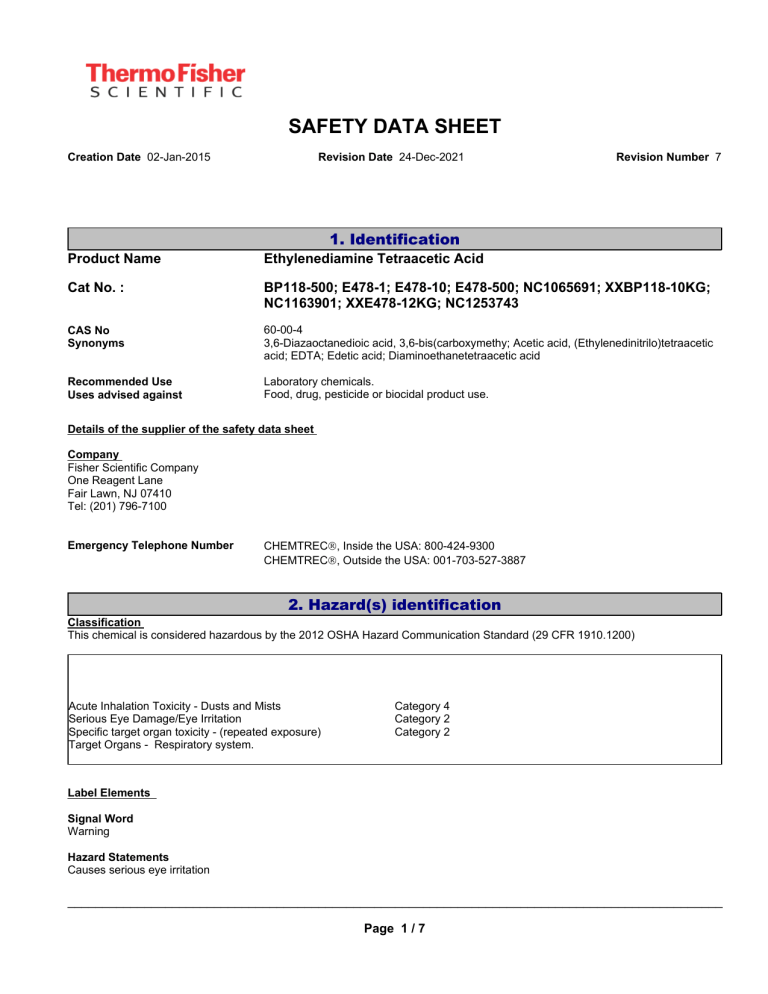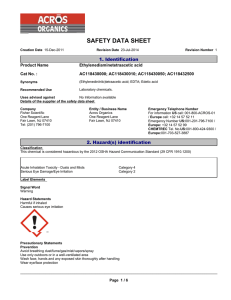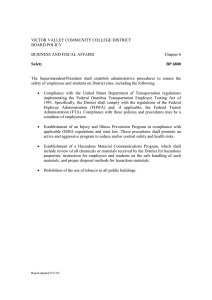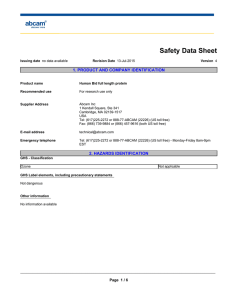
SAFETY DATA SHEET Creation Date 02-Jan-2015 Revision Date 24-Dec-2021 Revision Number 7 1. Identification Product Name Ethylenediamine Tetraacetic Acid Cat No. : BP118-500; E478-1; E478-10; E478-500; NC1065691; XXBP118-10KG; NC1163901; XXE478-12KG; NC1253743 CAS No Synonyms 60-00-4 3,6-Diazaoctanedioic acid, 3,6-bis(carboxymethy; Acetic acid, (Ethylenedinitrilo)tetraacetic acid; EDTA; Edetic acid; Diaminoethanetetraacetic acid Recommended Use Uses advised against Laboratory chemicals. Food, drug, pesticide or biocidal product use. Details of the supplier of the safety data sheet Company Fisher Scientific Company One Reagent Lane Fair Lawn, NJ 07410 Tel: (201) 796-7100 Emergency Telephone Number CHEMTRECÒ, Inside the USA: 800-424-9300 CHEMTRECÒ, Outside the USA: 001-703-527-3887 2. Hazard(s) identification Classification This chemical is considered hazardous by the 2012 OSHA Hazard Communication Standard (29 CFR 1910.1200) Acute Inhalation Toxicity - Dusts and Mists Serious Eye Damage/Eye Irritation Specific target organ toxicity - (repeated exposure) Target Organs - Respiratory system. Category 4 Category 2 Category 2 Label Elements Signal Word Warning Hazard Statements Causes serious eye irritation ______________________________________________________________________________________________ Page 1 / 7 Revision Date 24-Dec-2021 Ethylenediamine Tetraacetic Acid ______________________________________________________________________________________________ Harmful if inhaled May cause damage to organs through prolonged or repeated exposure Precautionary Statements Prevention Use only outdoors or in a well-ventilated area Wash face, hands and any exposed skin thoroughly after handling Wear eye/face protection Do not breathe dust/fume/gas/mist/vapors/spray Response Get medical attention/advice if you feel unwell Inhalation IF INHALED: Remove victim to fresh air and keep at rest in a position comfortable for breathing Call a POISON CENTER or doctor/physician if you feel unwell Eyes IF IN EYES: Rinse cautiously with water for several minutes. Remove contact lenses, if present and easy to do. Continue rinsing If eye irritation persists: Get medical advice/attention Disposal Dispose of contents/container to an approved waste disposal plant Hazards not otherwise classified (HNOC) None identified 3. Composition/Information on Ingredients Component Ethylenediamine tetraacetic acid (EDTA) CAS No 60-00-4 Weight % > 99 4. First-aid measures General Advice If symptoms persist, call a physician. Eye Contact Rinse immediately with plenty of water, also under the eyelids, for at least 15 minutes. Obtain medical attention if irritation persists. Skin Contact Wash off immediately with plenty of water for at least 15 minutes. If skin irritation persists, call a physician. Inhalation Remove to fresh air. If not breathing, give artificial respiration. Get medical attention if symptoms occur. Ingestion Clean mouth with water and drink afterwards plenty of water. Get medical attention if symptoms occur. Most important symptoms and effects Notes to Physician None reasonably foreseeable. Treat symptomatically 5. Fire-fighting measures ______________________________________________________________________________________________ Page 2 / 7 Revision Date 24-Dec-2021 Ethylenediamine Tetraacetic Acid ______________________________________________________________________________________________ Suitable Extinguishing Media Water spray, carbon dioxide (CO2), dry chemical, alcohol-resistant foam. Unsuitable Extinguishing Media No information available Not applicable No information available Flash Point Method - 200 °C / 392 °F Autoignition Temperature Explosion Limits No data available Upper No data available Lower Sensitivity to Mechanical Impact No information available Sensitivity to Static Discharge No information available Specific Hazards Arising from the Chemical Thermal decomposition can lead to release of irritating gases and vapors. Keep product and empty container away from heat and sources of ignition. Hazardous Combustion Products Nitrogen oxides (NOx). Carbon monoxide (CO). Carbon dioxide (CO2). Protective Equipment and Precautions for Firefighters As in any fire, wear self-contained breathing apparatus pressure-demand, MSHA/NIOSH (approved or equivalent) and full protective gear. NFPA Health 2 Flammability 1 Instability 0 Physical hazards N/A 6. Accidental release measures Use personal protective equipment as required. Ensure adequate ventilation. Avoid dust formation. Do not flush into surface water or sanitary sewer system. Personal Precautions Environmental Precautions Methods for Containment and Clean Sweep up and shovel into suitable containers for disposal. Keep in suitable, closed containers for disposal. Up 7. Handling and storage Handling Wear personal protective equipment/face protection. Ensure adequate ventilation. Avoid dust formation. Do not get in eyes, on skin, or on clothing. Avoid ingestion and inhalation. Storage. Keep in a dry, cool and well-ventilated place. Keep container tightly closed. Incompatible Materials. Strong oxidizing agents. Strong bases. Metals. copper. 8. Exposure controls / personal protection Exposure Guidelines This product does not contain any hazardous materials with occupational exposure limitsestablished by the region specific regulatory bodies. Engineering Measures Ensure adequate ventilation, especially in confined areas. Ensure that eyewash stations and safety showers are close to the workstation location. Personal Protective Equipment Eye/face Protection Wear appropriate protective eyeglasses or chemical safety goggles as described by OSHA's eye and face protection regulations in 29 CFR 1910.133 or European Standard ______________________________________________________________________________________________ Page 3 / 7 Revision Date 24-Dec-2021 Ethylenediamine Tetraacetic Acid ______________________________________________________________________________________________ EN166. Skin and body protection Wear appropriate protective gloves and clothing to prevent skin exposure. Respiratory Protection Follow the OSHA respirator regulations found in 29 CFR 1910.134 or European Standard EN 149. Use a NIOSH/MSHA or European Standard EN 149 approved respirator if exposure limits are exceeded or if irritation or other symptoms are experienced. Hygiene Measures Handle in accordance with good industrial hygiene and safety practice. 9. Physical and chemical properties Powder Solid White Odorless No information available 2.5 10 g/L (23°C) 220 °C / 428 °F No information available Not applicable Not applicable No information available Physical State Appearance Odor Odor Threshold pH Melting Point/Range Boiling Point/Range Flash Point Evaporation Rate Flammability (solid,gas) Flammability or explosive limits Upper Lower Vapor Pressure Vapor Density Specific Gravity Solubility Partition coefficient; n-octanol/water Autoignition Temperature Decomposition Temperature Viscosity Molecular Formula Molecular Weight No data available No data available 0.013 hPa @ 20 °C Not applicable 0.86 @ 20°C Slightly soluble in water No data available 200 °C / 392 °F > 150°C Not applicable C10 H16 N2 O8 292.23 10. Stability and reactivity Reactive Hazard None known, based on information available Stability Stable under normal conditions. Conditions to Avoid Avoid dust formation. Incompatible products. Excess heat. Incompatible Materials Strong oxidizing agents, Strong bases, Metals, copper Hazardous Decomposition Products Nitrogen oxides (NOx), Carbon monoxide (CO), Carbon dioxide (CO2) Hazardous Polymerization Hazardous polymerization does not occur. Hazardous Reactions None under normal processing. 11. Toxicological information Acute Toxicity Product Information Component Information Component Ethylenediamine tetraacetic acid (EDTA) LD50 Oral 4500 mg/kg ( Rat ) >2000 mg/kg ( Rat ) LD50 Dermal Not listed LC50 Inhalation 1 mg/l (rat) ______________________________________________________________________________________________ Page 4 / 7 Revision Date 24-Dec-2021 Ethylenediamine Tetraacetic Acid ______________________________________________________________________________________________ No information available Toxicologically Synergistic Products Delayed and immediate effects as well as chronic effects from short and long-term exposure Irritation Irritating to eyes Sensitization No information available Carcinogenicity The table below indicates whether each agency has listed any ingredient as a carcinogen. Component Ethylenediamine tetraacetic acid (EDTA) CAS No 60-00-4 IARC Not listed NTP Not listed Mutagenic Effects No information available Reproductive Effects No information available. Developmental Effects No information available. Teratogenicity No information available. STOT - single exposure STOT - repeated exposure None known Respiratory system Aspiration hazard No information available ACGIH Not listed OSHA Not listed Mexico Not listed Symptoms / effects,both acute and No information available delayed Endocrine Disruptor Information No information available Other Adverse Effects The toxicological properties have not been fully investigated. 12. Ecological information Ecotoxicity Contains a substance which is:. The product contains following substances which are hazardous for the environment. Toxic to aquatic organisms. Component Ethylenediamine tetraacetic acid (EDTA) Freshwater Algae EC50: = 1.01 mg/L, 72h (Desmodesmus subspicatus) Freshwater Fish LC50: 34 - 62 mg/L, 96h static (Lepomis macrochirus) LC50: 44.2 - 76.5 mg/L, 96h static (Pimephales promelas) Microtox Not listed Water Flea EC50: = 113 mg/L, 48h Static (Daphnia magna) Persistence and Degradability Soluble in water Persistence is unlikely based on information available. Bioaccumulation/ Accumulation No information available. Mobility Will likely be mobile in the environment due to its water solubility. Waste Disposal Methods Chemical waste generators must determine whether a discarded chemical is classified as a hazardous waste. Chemical waste generators must also consult local, regional, and national hazardous waste regulations to ensure complete and accurate classification. DOT TDG Not regulated Not regulated 13. Disposal considerations 14. Transport information ______________________________________________________________________________________________ Page 5 / 7 Revision Date 24-Dec-2021 Ethylenediamine Tetraacetic Acid ______________________________________________________________________________________________ Not regulated Not regulated IATA IMDG/IMO 15. Regulatory information United States of America Inventory Component CAS No TSCA Ethylenediamine tetraacetic acid (EDTA) 60-00-4 X TSCA Inventory notification Active-Inactive ACTIVE TSCA - EPA Regulatory Flags - Legend: TSCA US EPA (TSCA) - Toxic Substances Control Act, (40 CFR Part 710) X - Listed '-' - Not Listed Not applicable TSCA 12(b) - Notices of Export International Inventories Canada (DSL/NDSL), Europe (EINECS/ELINCS/NLP), Philippines (PICCS), Japan (ENCS), Japan (ISHL), Australia (AICS), China (IECSC), Korea (KECL). Component Ethylenediamine tetraacetic acid (EDTA) CAS No 60-00-4 DSL X NDSL - EINECS 200-449-4 PICCS X ENCS X ISHL X AICS X IECSC X KECL KE-13648 KECL - NIER number or KE number (http://ncis.nier.go.kr/en/main.do) U.S. Federal Regulations SARA 313 Not applicable SARA 311/312 Hazard Categories See section 2 for more information CWA (Clean Water Act) Component Ethylenediamine tetraacetic acid (EDTA) CWA - Hazardous Substances X Clean Air Act Not applicable OSHA - Occupational Safety and Health Administration Not applicable CWA - Reportable Quantities 5000 lb CWA - Toxic Pollutants CWA - Priority Pollutants - - CERCLA Component Ethylenediamine tetraacetic acid (EDTA) Hazardous Substances RQs 5000 lb CERCLA EHS RQs - This product does not contain any Proposition 65 chemicals. California Proposition 65 U.S. State Right-to-Know Regulations Component Ethylenediamine tetraacetic acid (EDTA) Massachusetts X New Jersey X Pennsylvania X Illinois - Rhode Island - U.S. Department of Transportation ______________________________________________________________________________________________ Page 6 / 7 Revision Date 24-Dec-2021 Ethylenediamine Tetraacetic Acid ______________________________________________________________________________________________ Reportable Quantity (RQ): DOT Marine Pollutant DOT Severe Marine Pollutant Y N N U.S. Department of Homeland Security This product does not contain any DHS chemicals. Other International Regulations Mexico - Grade No information available Authorisation/Restrictions according to EU REACH Component REACH (1907/2006) - Annex XIV - REACH (1907/2006) - Annex XVII REACH Regulation (EC Substances Subject to Restrictions on Certain Dangerous 1907/2006) article 59 - Candidate Authorization Substances List of Substances of Very High Concern (SVHC) Ethylenediamine tetraacetic acid Use restricted. See item 75. (EDTA) (see link for restriction details) https://echa.europa.eu/substances-restricted-under-reach Safety, health and environmental regulations/legislation specific for the substance or mixture Component CAS No OECD HPV Persistent Organic Pollutant Ozone Depletion Potential Ethylenediamine tetraacetic acid (EDTA) 60-00-4 Listed Not applicable Not applicable Restriction of Hazardous Substances (RoHS) Not applicable Component CAS No Rotterdam Convention (PIC) Basel Convention (Hazardous Waste) Ethylenediamine tetraacetic acid (EDTA) 60-00-4 Not applicable Not applicable Seveso III Directive Seveso III Directive (2012/18/EC) (2012/18/EC) Qualifying Quantities Qualifying Quantities for Major Accident for Safety Report Notification Requirements Not applicable Not applicable 16. Other information Prepared By Regulatory Affairs Thermo Fisher Scientific Email: EMSDS.RA@thermofisher.com Creation Date Revision Date Print Date Revision Summary 02-Jan-2015 24-Dec-2021 24-Dec-2021 This document has been updated to comply with the US OSHA HazCom 2012 Standard replacing the current legislation under 29 CFR 1910.1200 to align with the Globally Harmonized System of Classification and Labeling of Chemicals (GHS). Disclaimer The information provided in this Safety Data Sheet is correct to the best of our knowledge, information and belief at the date of its publication. The information given is designed only as a guidance for safe handling, use, processing, storage, transportation, disposal and release and is not to be considered a warranty or quality specification. The information relates only to the specific material designated and may not be valid for such material used in combination with any other materials or in any process, unless specified in the text End of SDS ______________________________________________________________________________________________ Page 7 / 7







